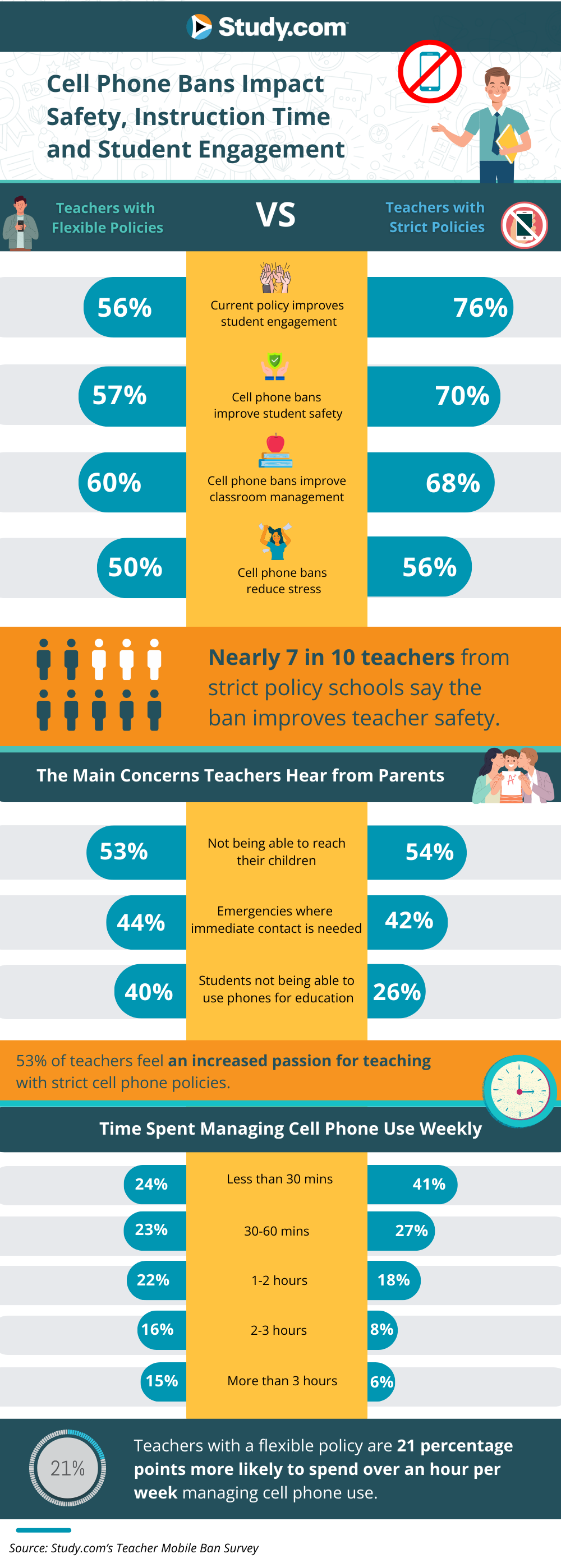
76% of teachers say strict cell phone bans boost student engagement: A closer look at classroom policies
76% of teachers say strict cell phone bans boost student engagement: A closer look at classroom policies
A recent Study.com survey found that 76% of teachers working in schools with strict cell phone policies believe that cell phone bans increase student engagement. Even though the school year has just started, teachers' frustrations with managing cell phones have already begun to fuel debates nationwide regarding cell phone use in classrooms. Study.com shares insights from educators around the issue.
Many educators are concerned about the distractions phones cause, and states like Virginia, Florida, and South Carolina are moving to enforce stricter cell phone policies. Virginia, for example, recently implemented a statewide ban, reflecting a growing trend toward minimizing digital distractions to improve focus and safety in schools.
Dr. Rebecca Blankenship, an associate professor in the College of Education at Florida A&M University, describes the challenge teachers face: "When teachers are in the classroom, they are competing against the mobile device in a child's hand... when some notification flashes on that phone, it gives an instant gratification that a human-to-human interaction cannot necessarily provide. Too much reliance on mobile phones can also promote lazy learning."
Methodology: Survey data for this article comes from the Study.com Cell Phone Ban Survey, which included over 1,000 middle and high school teachers. Additional supporting data comes from EdWeek, BallotPedia, Pew Research Center, the Kaiser Family Foundation, and the California Governor's Office.

Cell Phone Bans Keep Students Engaged and Schools Safe
The Study.com survey found that, with strict cell phone bans, 76% of teachers report better student engagement and 70% noticed improved safety in schools. These findings suggest that limiting phone use can enhance the learning environment by reducing distractions.
"Mobile phones are the bane of my existence," says Mindy Tuft, a teacher from a Title I school in Sacramento County. "But as a teacher, I don't know what our policy is." To address the issue, Mindy created her own system: "I reward students with scholar dollars for putting their phones away in a designated 'parking lot.' This encourages them to keep their devices out of sight during class."
Meanwhile, Dr. Blankenship adds that reducing phone use can have significant cognitive and socioemotional benefits for students. "We need to start shifting the conversation," she says. "Just because we can use [technology] in teaching and learning doesn't really mean that we always should. There is no substitute for the human-to-human experience in learning."
Tuft and Dr. Blankenship's perspectives highlight how managing cell phone use in schools can reduce distractions, encourage more meaningful student-teacher interactions and improve overall classroom safety.
The Debate Over Cell Phone Bans: Parents vs. Educators
While many teachers report benefits from strict cell phone bans, the topic remains controversial. Parents often worry about losing the ability to communicate with their children during emergencies. A Pew Research Center report found that nearly half of parents have concerns about not being able to reach their kids during school hours, highlighting a key sticking point in discussions around school cell phone policies.
Educators, on the other hand, argue that, while emergency communication is crucial, cell phones often lead to issues such as cyberbullying and disruption. They stress that minimizing distractions in the classroom is important to fostering effective learning. "It's about finding the right balance," says Dr. Michael Rich, a pediatrician and director of the Center on Media and Child Health, as quoted by EdWeek. "We need to respect the legitimate concerns of parents while also recognizing the importance of minimizing distractions that can hinder learning."
"If there's an emergency, parents can always call the school office to get a message to their child," says Dr. Blankenship, offering a practical solution to parents concerned about reaching their children. "We've set up multiple systems to ensure parents are notified immediately if something urgent happens. This way, we can maintain a focused learning environment without the constant distraction of phones in the classroom."
Regardless, this ongoing debate highlights the challenge that schools face when crafting policies that consider both safety and educational needs, balancing parental concerns with the need for a focused learning environment.
Real-World Examples and Challenges
Several schools and districts have implemented strict cell phone bans with positive results. Virginia recently joined states such as Florida and South Carolina, enforcing statewide bans to reduce distractions and improve student focus. California governor Gavin Newsom, urged all schools to restrict smartphone use, citing concerns about mental health and academic performance linked to excessive phone use. School districts like Los Angeles Unified have adopted these policies and report noticeable improvements in student concentration and fewer classroom disruptions.
Sharing her optimism regarding the success of stricter cell phone bans, Brandie Provenzano, a high school English teacher in Prince William County, Virginia, says, "I can tell already this will be my best year ever. Kids are so engaged and able to focus, and even though they probably would never admit it, they needed these boundaries. One student told me how they thought they had ADD, but now that the phone isn't allowed in class, they have no problems concentrating. Since the ban is state-wide, they don't have F.O.M.O. (fear of missing out) since their friends aren't on their phones either."
Enforcing these bans comes with its own set of challenges, though. Many schools face pushback from students and parents concerned about accessibility and communication. Consistent enforcement can be difficult, too, as policies may differ widely even within a single district. For instance, schools in South Carolina must enforce cell phone bans to receive state funding, adding a layer of compliance pressure. Meanwhile, Pennsylvania and Delaware have introduced pilot programs using cell phone pouches to restrict access during school hours, trying out more flexible approaches.
While many educators and policymakers recognize the benefits of stricter cell phone policies, the process of implementing them is not straightforward. To find success with stricter cell phone restrictions, schools must address varying viewpoints and find a way to balance educational needs with community concerns. With more states considering restrictions, the discussion around cell phone policies in schools is set to continue.



